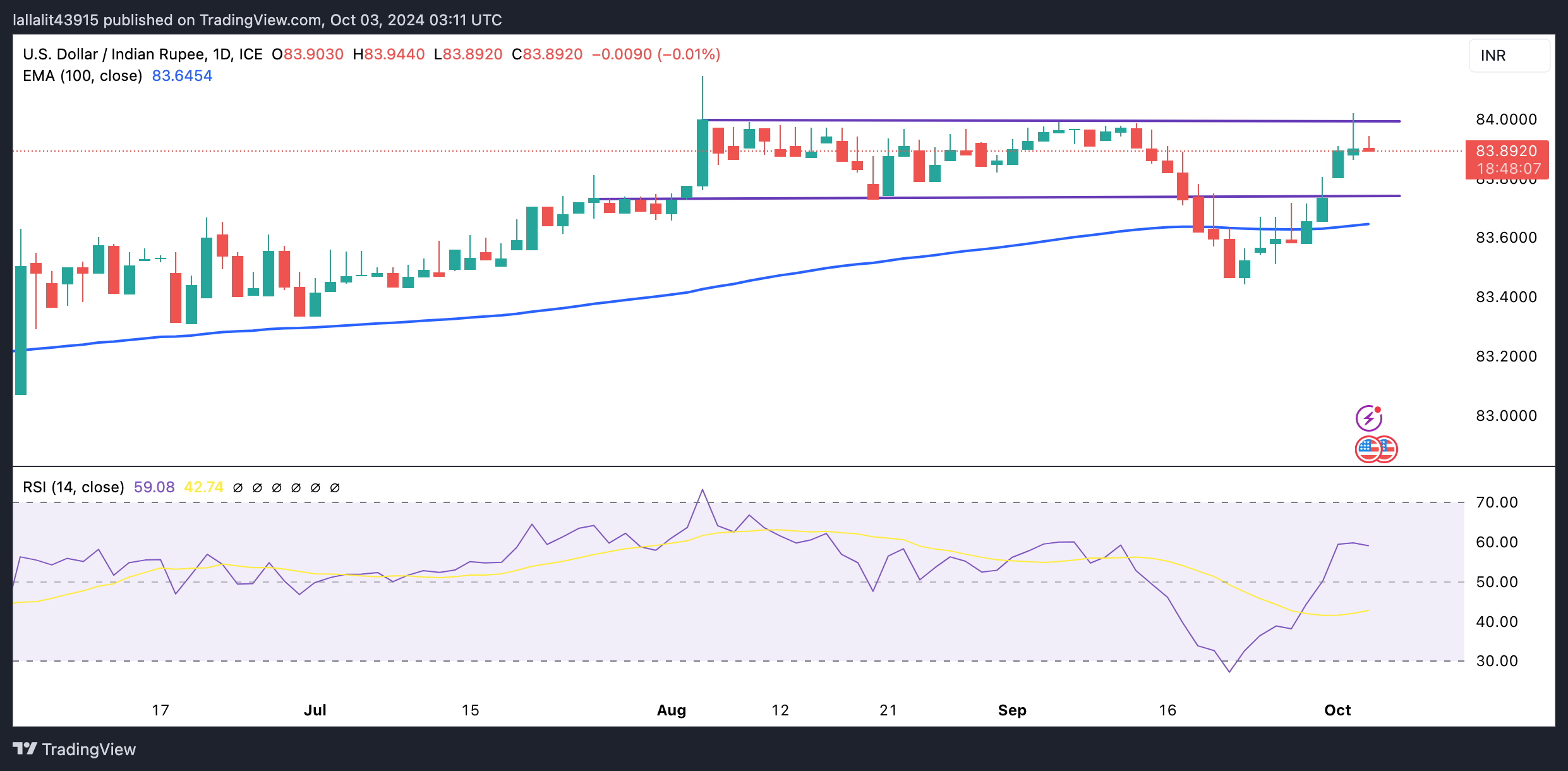USD/INR gathers strength as risk-off sentiment prevails
- Indian Rupee edges lower in Thursday’s Asian session.
- The risk-off sentiment and higher crude oil prices drag the INR lower.
- Investors await the US September ISM Services PMI on Thursday ahead of employment data.
The Indian Rupee (INR) softens on the day, pressured by the renewed US Dollar (USD) demand. The risk-off mood amid the escalating geopolitical tensions in the Middle East boosts the safe-haven flows, benefiting the Greenback. Additionally, the rise in crude oil prices exerts some selling pressure on the INR as India is the third-largest oil consumer after the United States (US) and China.
Looking ahead, investors will keep an eye on the US September ISM Services Purchasing Managers Index (PMI), the weekly Initial Jobless Claims and the final S&P Global Services PMI, which are due later on Thursday. The attention will shift to the US September employment data on Friday, including Nonfarm Payrolls (NFP), Unemployment Rate and the Average Hourly Earnings. If the jobs report showed a weaker-than-expected outcome, this could prompt the central bank to consider cutting rates deeper, which might exert some selling pressure on the USD.
Daily Digest Market Movers: Indian Rupee remains vulnerable amid multiple headwinds
- The HSBC final India Manufacturing PMI eased to an eight-month low of 56.5 in September. This figure was below the market consensus of 56.7 and the previous reading of 57.5.
- "Momentum in India's manufacturing sector softened in September from the very strong growth in the summer months," said Pranjul Bhandari, chief India economist at HSBC.
- According to the Reserve Bank of India’s (RBI) real effective exchange rate (REER) index, the Indian Rupee stood at 5.5% above its fair value in August, down from 7.7% in the previous month.
- The US ADP Employment Change data for September exceeded expectations, with 143,000 new jobs added. This figure was above the median forecast of 120,000 and the previous reading of 103,000 (revised from 99,000).
- Richmond Fed President Thomas Barkin said on Wednesday that the Fed's fight to return inflation to its 2% target may take longer than expected to complete and limit how far interest rates can be cut, per Reuters.
Technical Analysis: USD/INR maintains its constructive bias
The Indian Rupee softens on the day. According to the daily timeframe, the positive view of the USD/INR pair prevails as the price holds above the key 100-day Exponential Moving Average (EMA). Furthermore, the 14-day Relative Strength Index (RSI) crosses above the midline near 60.30, suggesting that the uptrend is more likely to resume than to reverse.
The crucial resistance level for the pair emerges at the 84.00 psychological mark. Sustained bullish momentum above this level could pave the way to 84.15, the high of August 5. The next upside barrier is seen at 84.50.
On the flip side, the initial support level for USD/INR is seen at 83.80, the low of October 1. A break lower could drag the pair further south to the 100-day EMA at 83.64, followed by 83.00, representing the round mark and the low of May 24.

Indian Rupee FAQs
The Indian Rupee (INR) is one of the most sensitive currencies to external factors. The price of Crude Oil (the country is highly dependent on imported Oil), the value of the US Dollar – most trade is conducted in USD – and the level of foreign investment, are all influential. Direct intervention by the Reserve Bank of India (RBI) in FX markets to keep the exchange rate stable, as well as the level of interest rates set by the RBI, are further major influencing factors on the Rupee.
The Reserve Bank of India (RBI) actively intervenes in forex markets to maintain a stable exchange rate, to help facilitate trade. In addition, the RBI tries to maintain the inflation rate at its 4% target by adjusting interest rates. Higher interest rates usually strengthen the Rupee. This is due to the role of the ‘carry trade’ in which investors borrow in countries with lower interest rates so as to place their money in countries’ offering relatively higher interest rates and profit from the difference.
Macroeconomic factors that influence the value of the Rupee include inflation, interest rates, the economic growth rate (GDP), the balance of trade, and inflows from foreign investment. A higher growth rate can lead to more overseas investment, pushing up demand for the Rupee. A less negative balance of trade will eventually lead to a stronger Rupee. Higher interest rates, especially real rates (interest rates less inflation) are also positive for the Rupee. A risk-on environment can lead to greater inflows of Foreign Direct and Indirect Investment (FDI and FII), which also benefit the Rupee.
Higher inflation, particularly, if it is comparatively higher than India’s peers, is generally negative for the currency as it reflects devaluation through oversupply. Inflation also increases the cost of exports, leading to more Rupees being sold to purchase foreign imports, which is Rupee-negative. At the same time, higher inflation usually leads to the Reserve Bank of India (RBI) raising interest rates and this can be positive for the Rupee, due to increased demand from international investors. The opposite effect is true of lower inflation.



